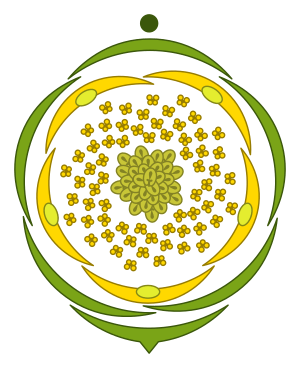Meadow buttercup facts for kids
Quick facts for kids Meadow buttercup |
|
|---|---|
 |
|
| Scientific classification | |
| Genus: |
Ranunculus
|
| Species: |
acris
|
| Synonyms | |
|
|
Ranunculus acris, also known as the meadow buttercup, is a bright yellow flower found all over Europe and parts of Asia. It's one of the most common types of buttercups you might see. People also call it the tall buttercup or common buttercup.
Contents
What Does the Meadow Buttercup Look Like?
The meadow buttercup is a plant that comes back every year. It can grow quite tall, usually between 30 to 70 centimeters (about 1 to 2.3 feet) high. Its stems are smooth and shiny.
Flower Features
The flowers are a glossy yellow and about 25 millimeters (1 inch) wide. Each flower has five petals that overlap each other. Underneath the petals are five green parts called sepals. These sepals turn yellow as the flower gets older. The flower also has many stamens, which are the parts that make pollen.
Leaves and Seeds
The leaves of the meadow buttercup are divided into three parts. Unlike some other buttercups, the end leaflet is attached directly to the stem. After the flower blooms, it produces many small seeds. These seeds are called achenes.
Where Do Meadow Buttercups Grow?
The meadow buttercup is originally from Europe and Asia. However, it has spread to many other parts of the world. You can now find it almost everywhere, including North America.
Global Spread
In places like Alaska and Greenland, it might have grown there naturally. But in many other areas, it was brought by people and now grows wild. Sometimes, it can even become a weed in gardens or fields.
Impact on Farms
In New Zealand, for example, it's a big problem for dairy farms. It costs the dairy industry a lot of money each year. This plant has even become resistant to some chemicals used to kill weeds.
Growing Meadow Buttercups
While some people see the meadow buttercup as a pesky weed, others like to have it around. It can pop up in lawns and on paths.
In Gardens
However, it's also a lovely addition to a wildflower meadow. There's even a special type called 'Flore Pleno' that has double flowers. This type has won an award for being a great garden plant!
Is the Meadow Buttercup Safe?
It's important to know that meadow buttercups are not good to eat. The plant contains oils, especially in its leaves and stems.
Effects on Animals
If animals eat too much of it, they can get sick. It can cause tummy aches and other problems. So, it's best to keep animals away from large amounts of this plant.
How Native Americans Used This Plant
Long ago, different Native American tribes used the meadow buttercup for various purposes. They used it in traditional ways for health and well-being.
Traditional Uses
- The Abenaki people would crush the flowers and leaves. They would then sniff them to help with headaches.
- The Bella Coola tribe used a paste made from the roots. They would put this paste on boils to help them heal.
- The Micmac people also used the leaves to help with headaches.
- The Montagnais tribe would breathe in the smell of crushed leaves for headaches too.
- The Cherokee people used it in several ways. They made a paste for abscesses. They also made a special drink for mouth sores. Sometimes, they even cooked and ate the leaves as greens.
- The Iroquois tribe used the crushed plant on the chest for pain and colds. They also made a drink from the roots for diarrhea.
See also
 In Spanish: Botón de oro común para niños
In Spanish: Botón de oro común para niños


